Subcontracting Process for Discrete Manufacturing
This chapter covers the following topics:
- Subcontracting Planning for Discrete Manufacturing
- Subcontracting Process Execution for Discrete Manufacturing
Subcontracting Planning for Discrete Manufacturing
The following sections describe the Subcontracting planning processes for discrete manufacturing:
Note: Chargeable Subcontracting , Buy/Sell Subcontracting and Full Outsourcing share the same subcontracting planning process.
Overview
In the Subcontracting solution, Advanced Supply Chain Planning (ASCP) plans the component requirements in both OEM and MP organizations, and uses organization definitions (customer supplier associations) and sourcing rules defined as a part of the subcontracting setup steps. ASCP nets the demand and supply and creates planned orders for the components and assemblies in both the OEM and MP organizations. The setup for ASCP is the same as those of the standard planning setup for items. No special setups are required for subcontracting.
The steps required to set up and run ASCP are summarized as follows:
-
Add OEM and MP organizations to the planning instance.
-
Run collections and transfer data (items, sourcing rules, demand, supply, and so on) to the planning instance.
-
Define Organization security to run the plans for the OEM and MP organizations.
-
Define forecast sets for outsourced assembly if the outsourced assembly is an independent demand item. Otherwise, no forecast set definition is required.
-
Create and run the supply chain plans.
-
View the newly created planned orders by using the Planner Workbench.
For more detailed planning setup, refer to the Oracle Advanced Supply Chain Planning User's Guide.
Outsourced Assembly with Synchronized Components
In this scenario, the outsourced assembly is A and its components, B and C, are synchronized components.

The Planning process starts when:
-
The forecast is defined for an outsourced assembly in the OEM organization, if the outsourced assembly A is an independent demand item. If A is a dependent demand item, the demand comes from its parent assembly.
-
The planning run considers the forecast or dependent demand of A, calculates the net requirements of A in the OEM organization, and creates a buy planned order for assembly A in the OEM organization. A is a buy item and is sourced from MP organization, based on the sourcing rule and Organization Supplier customer associations. Therefore, the planned order demand of A in the OEM organization is transferred to the MP organization as demand of A.
-
In the MP organization, A is a make item, for which demand is netted, and a make planned order is created for Assembly A. When the BOM is exploded, components B and C requirements are calculated, netted, and buy planned orders are created. Since these components are sourced from the OEM organization (based on the sourcing rules, supplier and site associations of the OEM organization), the buy planned order demand for components B and C is transferred to the OEM organization.
-
In the OEM organization, components B and C requirements are netted because these components are sourced from RMS (based on sourcing rules) so, buy planned orders are created for these components in the OEM organization.
-
In the OEM organization, buy planned orders can be transferred from Planning to Purchasing as purchase requisitions. (The release time fence is set to Null for outsourced assembly A, and components B and C in Organization Items.) Purchase orders and blanket releases are created from these purchase requisitions. Purchase orders and blanket releases created for outsourced assemblies are referred to as subcontracting orders.
-
In the MP organization, make and buy planned orders of the outsourced assembly A and components B and C cannot be transferred as WIP jobs or purchase requisitions because the Release time fence is set to Don't Release Auto or Manual for all of them in the MP organization. For these planned orders, the Attribute Action is set to None, which prevents releasing these planned orders.
Note: You can view planned work orders using the Planner Workbench.
The Interlock Manager concurrent request creates WIP jobs for assembly A and purchase orders for components B and C during the simulation run. This topic is discussed in detail in the execution section. These WIP jobs and purchase orders represent supply and are considered in subsequent planning runs.
For more information on concurrent programs, see Overview of Subcontracting Concurrent Programs.
Outsourced Assembly with Prepositioned Components
In this scenario, the outsourced assembly is A and its components, B and C, are prepositioned components:
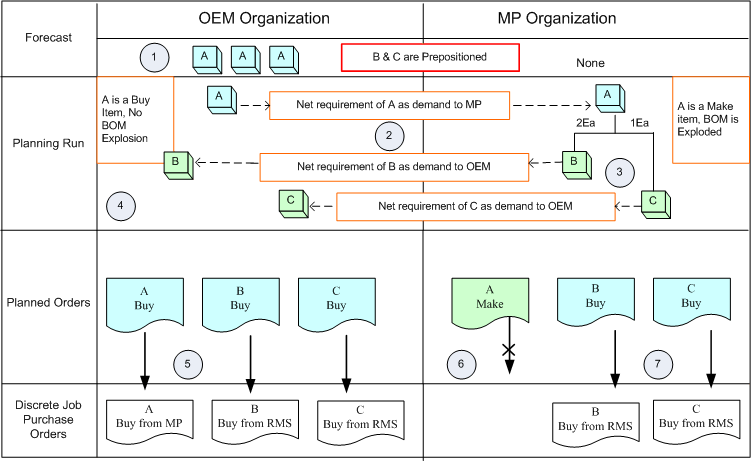
The planning process is the same as that of the outsourced assembly with synchronized components. The only exception is that planned orders of prepositioned components B and C can be transferred to Purchasing as purchase requisitions:
-
The forecast is defined for the outsourced assembly in the OEM organization, if the outsourced assembly A is an independent demand item. If A is a dependent demand item, demand comes from its parent assembly.
-
The planning run considers forecast or dependent demand of A, calculates the net requirements of A in the OEM organization, and creates a buy planned order for assembly A in the OEM organization. Since Assembly A is a buy item and is sourced from the MP organization, the planned order demand of A in the OEM organization is transferred to the MP organization as demand of A.
-
In the MP organization, A is a make item based on the organization, demand is net calculation, and a make planned order is created for Assembly A. When the BOM is exploded, the requirements for components B and C are calculated, the net calculated, and buy planned orders are created. Since these components are sourced from the OEM organization, buy planned order demand of components B and C is transferred to the OEM organization.
-
In the OEM organization, requirements for components B and C are netted because these components are sourced from RMS (based on sourcing rules). Therefore, buy planned orders are created for these components in OEM organization
-
In the OEM organization, buy planned orders can be transferred from Planning to Purchasing as purchase requisitions. (The release time fence is set to Null for outsourced assembly A, components B and C in organization items). Purchase orders and blanket releases are created from these purchase requisitions. Purchase orders and blanket releases created for the outsourced assemblies are referred to as subcontracting orders.
-
In the MP organization, make planned orders of outsourced assembly A can be transferred as WIP jobs as the release time fence is set to Don't Release Auto or Manual for the outsourced assembly in MP organization. The make planned order Attribute Action is set to None (it can be viewed on the planning workbench), which prevents the release of these planned orders.
-
Buy Planned orders of components B and C can be transferred to Purchasing as requisitions as the release time fence is set to Null for both the components in the MP organization.
The Interlock Manager concurrent request creates WIP jobs for assembly A during the interlock run. These WIP jobs represent supply, and are considered in subsequent planning runs.
For more information on concurrent programs, see Overview of Subcontracting Concurrent Programs.
Outsourced Assembly with Prepositioned and Synchronized Components
In this scenario, the outsourced assembly is A and its components, B and C are prepositioned and synchronized components respectively:
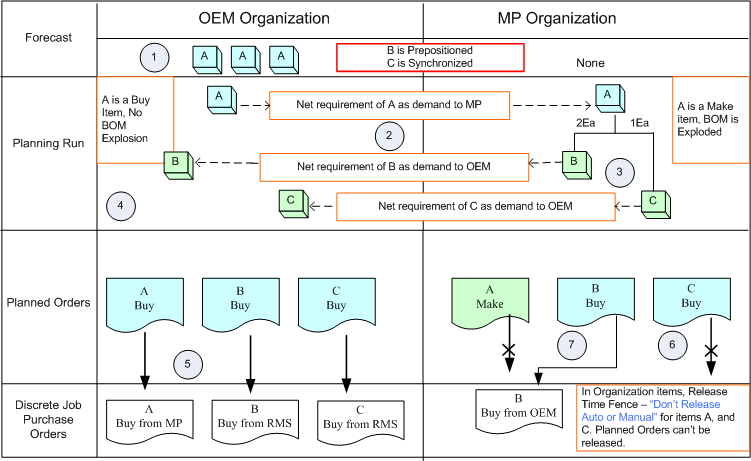
The planning process is a combination of the given processes involving synchronized components and prepositioned components:
-
The forecast is defined for the outsourced assembly in the OEM organization, if the outsourced assembly A is an independent demand item. If A is a dependent demand item, then demand comes from its parent assembly.
-
The planning run considers forecast or dependent demand of A, calculates the net the requirements of A in the OEM organization, and creates a buy planned order for assembly A in the OEM organization. A is a buy item that is sourced from the MP organization, therefore, the planned order demand of A in the OEM organization is transferred to the MP organization as demand of A.
-
In the MP organization, A is a make item, demand is netted, and a make planned order is created for Assembly A. When the BOM is exploded, components B and C requirements are calculated, netted, and buy planned orders are created. Since these components are sourced from the OEM organization, the buy planned order demand of components B and C is transferred to the OEM organization.
-
In the OEM organization, components B and C requirements are netted, these components are sourced from the RMS (based on sourcing rules), and the buy planned orders are created for these components in the OEM organization.
-
In the OEM organization, buy planned orders can be transferred from Planning to Purchasing as purchase requisitions. Purchase orders and blanket releases are created from these purchase requisitions. Purchase orders and blanket releases created for the outsourced assembly are referred to as subcontracting orders.
-
In the MP organization, make planned orders of outsourced assembly A and Buy Planned orders of Component C cannot be transferred as WIP jobs because purchase requisitions as the Release Time Fence is set to Don't Release Auto or Manual in the MP organization. The Planned Order Attribute Action is set to None which prevents releasing these planned orders. You can use the Planner Workbench to view the planned orders.
-
Buy planned orders of components B can be transferred to Purchasing as requisitions as the Release Time Fence is set to Null for both the components in MP organization.
The Interlock Manager concurrent request creates WIP jobs for assembly A and replenishment purchase orders for component B during the interlock run. These WIP jobs and replenishment purchase orders represent supply, and are considered in the subsequent planning runs.
For more information on concurrent programs, see Overview of Subcontracting Concurrent Programs.
Subcontracting Process Execution for Discrete Manufacturing
The Subcontracting execution process begins with the subcontracting orders for the outsourced assemblies and the replenishment purchase orders for the components. The following sections detail the process steps for each scenario.
Note: Creating price breaks for subcontract order shipments is not recommended. This can have downstream implications on financials.
Outsourced Assembly with Synchronized Components (External MP Organizations)
In this scenario, the execution starts with the subcontracting orders being transferred from ASCP. You can also create subcontracting orders manually.
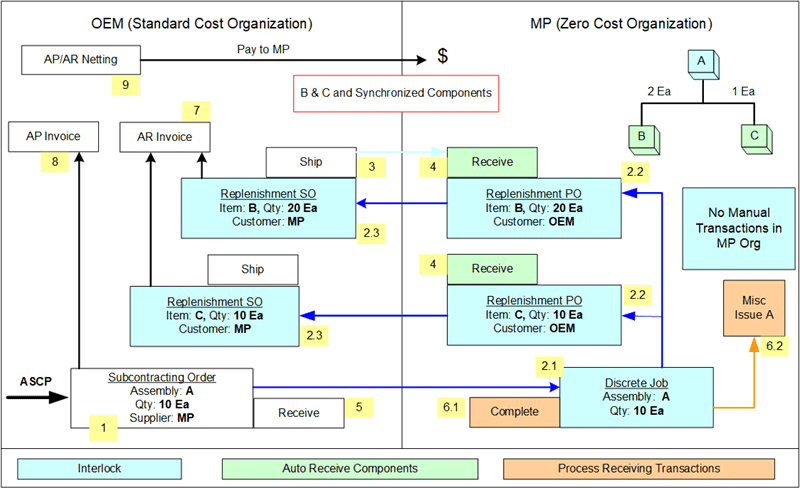
-
The execution process starts with the subcontracting order of Assembly A. These subcontracting orders are the standard purchase orders and blanket releases.
-
Interlock Manager picks up the subcontracting orders which were not processed in the previous run of the Interlock Manager and performs the following:
-
2.1. The Interlock Manager creates a discrete job for the subcontracted order quantity for simulating the manufacturing in the MP organization.
-
2.2. The OEM supplies components B and C which are required to manufacture this assembly . Since B and C are synchronized components, (meaning that these components need to be shipped along with the order), the Interlock Manager creates a replenishment purchase order for the components with the supplier associated with the OEM organization. The replenishment purchase order created in the MP organization denotes the supply and is considered by ASCP as supply.
-
2.3. The Interlock Manager also creates a replenishment sales order for shipping the components in the OEM for the corresponding replenishment purchase order in the MP organization. Replenishment sales orders created in the OEM will always have reference to its corresponding purchase order in the MP organization. Order type is retrieved from shipping networks (From Org: OEM and To Org: MP). The subcontracting default order type and the components price are picked from price lists associated with the customer site in the sales order (defined in the price lists setup). Sales orders are always created with a booked status and are ready for shipment. These replenishment sales orders are allocated to the respective subcontracting orders to meet the component requirements for manufacturing the assembly at the MP's site. (The Allocations table in the Subcontracting Data Model holds this information for tracking.)
-
-
Replenishment sales orders created for the subcontracting components are used for shipping the components like any other standard sales orders.
-
The Auto Receive Components concurrent request picks up these shipments in the OEM organization, and creates receipts in the MP organization against the corresponding purchase order. Sales orders with shipped date and the in-transit lead time (defined in the shipping networks default shipping method) that is less than or equal to the current date, are automatically received to simulate the receipts in the MP organization.
-
The MP manufactures the components and ships the manufactured assemblies to the OEM, and the OEM receives these receipts like other purchase order receipts.
-
The Process Receiving Transactions concurrent request picks up these receipts in the OEM organization and performs the following:
-
6.1. Completes the WIP job for the assembly. When the WIP job is completed , components are backflushed, and the inventory is reduced in the MP organization. However, the completed assembly in the MP remains in inventory.
-
6.2. Reduces the inventory of assemblies (completed through discrete jobs) in the MP organization by performing miscellaneous issues, to maintain the accuracy of the inventory records. This is because, the subcontracting order of the assembly is normally received in the OEM after the MP manufactures the assembly and sends it to the OEM.The Offset account defined in shipping networks is used for creating miscellaneous issues.
-
-
AR invoices are created for those components shipped to the MP.
-
AP invoices are created for subcontracting orders received from the MP.
-
In Payables, based on the Netting agreement, AP and AR invoices are netted and payment is made to the MP.
Note: This step is optional for Buy/Sell Subcontracting and not required for Full Outsourcing.
For more information on concurrent programs, see Overview of Subcontracting Concurrent Programs.
Outsourced Assembly with Prepositioned Components (External MP Organizations)
In this scenario, process execution begins with the subcontracting orders for the outsourced assembly and the replenishment purchase orders for the prepositioned components transferred from ASCP. You can also create subcontracting orders for outsourced assemblies and replenishment purchase orders for prepositioned components manually.
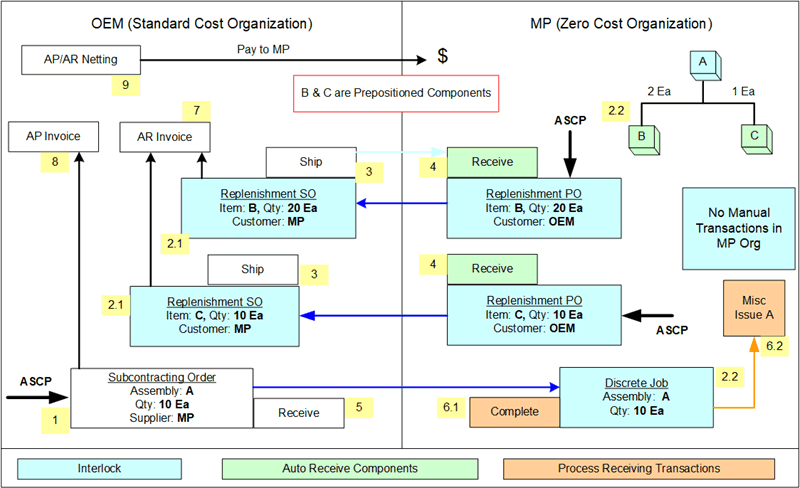
-
The execution process begins with the subcontracting order of the Assembly A and replenishment purchase orders of the prepositioned components. Subcontracting orders are the standard purchase orders and blanket releases. Replenishment purchase orders are the standard purchase orders or blanket releases created to simulate how MP procures components from the OEM.
-
Interlock Manager concurrent request selects:
-
2.1. Replenishment purchase orders of the components in the MP, and creates corresponding replenishment sales orders in the OEM for shipment of components to the MP. Replenishment sales orders that are created in the OEM always reference their associated purchase orders in the MP organization. The order type is retrieved from default order type of the shipping network (From Org: OEM and To Org: MP), and the components price is retrieved from the price lists associated with the customer site in the sales order. Sales orders are always created with booked status and are ready for shipment.
-
2.2. Interlock Manager then picks up the subcontracting orders that were not processed in the previous run of the Interlock Manager and creates a discrete job for the subcontracted order quantity for simulating the manufacturing in the MP organization. For manufacturing this assembly, components B and C are required in the MP organization, and the OEM must supply those materials to the MP. Since B and C are prepositioned components, meaning that components would have been shipped ahead of requirements, Interlock Manager does not create replenishment purchase orders or sales orders for these components. Instead, it looks for previously created and unallocated sales orders, and then makes allocations to these requirements. If unallocated replenishment sales orders are insufficient for the subcontracting order requirements, then Interlock Manager allocates to the available quantity and leaves the remaining quantity unallocated. (This situation should not happen if replenishments are available). If replenishments are available, then Interlock Manager attempts to allocate them in subsequent interlock runs.
-
-
Replenishment sales orders created for the subcontracting components are used for shipping the components like any other standard sales orders.
-
The Auto Receive Components concurrent request picks up these shipments in the OEM organization and creates receipts against the associated purchase orders in the MP organization. Sales orders with shipped date and in-transit lead time (defined in the shipping networks default shipping method) that is less than or equal to the current date will be automatically received to simulate the receipts in the MP organization.
-
The MP manufactures the components and ships the manufactured assemblies to the OEM, and the OEM receives these receipts like other purchase order receipts.
-
The Process Receiving Transactions concurrent request picks up these receipts in the OEM organization and:
-
6.1. Completes the WIP job for the assembly. When the WIP job is completed, components are backflushed, and the inventory is reduced in the MP organization. However, the completed assembly in the MP remains in inventory.
-
6.2. Reduces the inventory of assemblies (completed through discrete jobs) in the MP organization by performing miscellaneous issues, for maintaining the accuracy of the inventory records. This is because, the subcontracting order of the assembly is normally received in the OEM after the MP manufactures the assembly and sends it to the OEM. The Offset account defined in shipping networks is used for creating miscellaneous issues.
-
-
Account Receivables invoices are created for the components shipped to the MP.
-
Accounts Payables invoices are created for the subcontracting orders received from the MP.
-
In Payables, based on the Netting agreement, AP and AR invoices are netted and payment is made to the MP.
Note: This step is optional for Buy/Sell Subcontracting and not required for Full Outsourcing.
For more information on concurrent programs, see Overview of Subcontracting Concurrent Programs.
Outsourced Assembly with Prepositioned and Synchronized Components (External MP Organizations)
In this scenario, execution begins with the subcontracting orders of the outsourced assembly and replenishment purchase orders of the pre-positioned components being transferred from ASCP. Also, you can manually create subcontracting orders for the outsourced assembly and replenishment purchase orders for the pre-positioned components.
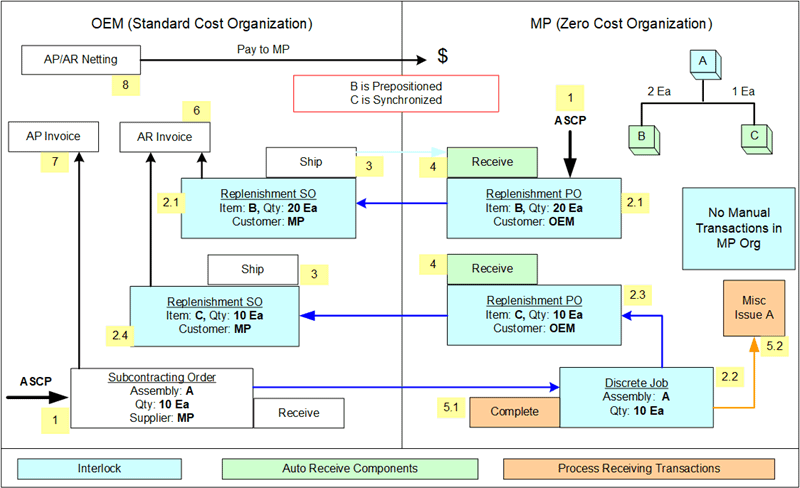
-
The execution process begins with the subcontracting order for assembly A and the replenishment purchase order for prepositioned component B.
-
The Interlock Manager concurrent request:
-
2.1 Picks up the replenishment purchase orders for component B in MP and creates associated replenishment sales orders in OEM for shipment to MP.
-
2.2 Interlock Manager then picks up the subcontracting orders that were not processed in the previous run, and creates discrete jobs for the subcontracting order quantity. To manufacture this assembly, MP needs components B and C, and OEM must supply those materials to MP.
Because Component B is a prepositioned component, Interlock Manager looks for available replenishment sales orders and attempts to allocate them to satisfy the subcontracting order requirement.
-
2.3. Because component C is a synchronized component, Interlock Manager creates replenishment purchase order for this component.
-
2.4. Interlock Manager creates a replenishment sales order for component C with its associated replenishment purchase order in MP, and then allocates the sales order to the subcontracting order requirements.
Note: Replenishment sales orders are created for shipping the components like other sales orders.
-
-
The Auto Receive Components concurrent request picks up these shipments in OEM and creates receipts in MP using the associated purchase order. Sales orders whose shipped date and In transit Lead time (defined in the shipping networks default shipping method) are less than or equal to the current date will be automatically received to simulate the receipts in MP organization.
-
MP manufactures the assembly and ships the manufactured assembly to OEM. OEM receives these receipts like other purchase order receipts.
-
The Process Receiving Transactions concurrent request picks up these receipts in OEM and:
-
5.1. Completes the WIP job for the assembly. When the WIP job is completed, components are backflushed, and the inventory is reduced in the MP organization. However, the completed assembly in the MP remains in inventory.
-
5.2. Reduces the inventory of assemblies (completed through discrete jobs) in the MP organization by performing miscellaneous issues, for maintaining the accuracy of the inventory records. This is because, the subcontracting order of the assembly is normally received in the OEM after the MP manufactures the assembly and sends it to the OEM. The Offset account defined in shipping networks is used for creating miscellaneous issues.
-
-
Accounts Receivables invoices are created for components shipped to MP.
-
Accounts Payables invoices are created for subcontracting orders received from MP.
-
In Payables, based on the Netting agreement, AP and AR invoices are netted and payment is made to the MP.
Note: This step is optional for Buy/Sell Subcontracting and not required for Full Outsourcing.
For more information on concurrent programs, see Overview of Subcontracting Concurrent Programs.
Outsourced Assembly with Prepositioned and Synchronized Components (Internal MP Organization)
In this scenario, execution begins with the subcontracting orders of the outsourced assembly and replenishment purchase orders of the pre-positioned components being transferred from ASCP or manually created. Subcontracting orders are created for outsourced assemblies in OEM and corresponding subcontracting sales orders for the outsourced assemblies are created in the internal MP organization by Interlock Manager. All transactions in the internal MP organization are manual.
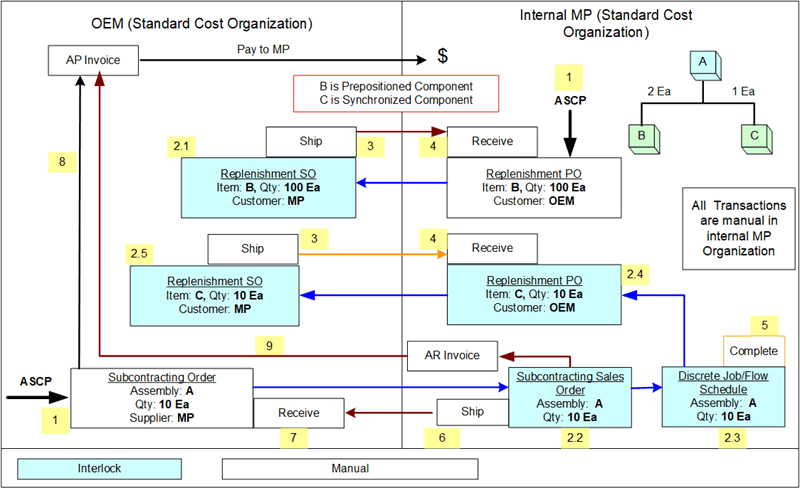
-
The execution process begins with the subcontracting order for assembly A and the replenishment purchase order for prepositioned component B.
-
The Interlock Manager concurrent request:
-
2.1 Picks up the replenishment purchase for component B in MP and creates associated replenishment sales orders in OEM for shipment to MP.
-
2.2 Picks up open subcontracting orders and creates subcontracting sales orders for Assembly A in the internal MP Organization
-
2.3 Creates the WIP job /Flow schedule for the subcontracting order quantity in the Internal MP. It associates the subcontracting sales order and WIP job/Flow schedule with the corresponding subcontracting order.
-
2.4 Creates replenishment purchase order for synchronized component C in MP.
-
2.5. Creates a replenishment sales order for component C in OEM, and then allocates the replenishment sales order to the subcontracting order requirements.
-
-
To manufacture this assembly, OEM must supply materials to the MP. OEM then ships the Subcontracting components B and C using the existing shipping process.
-
Components are automatically received in internal MP organizations using the Auto Receive Components program (see: Auto Receive Components for more details).
-
Once the component items are issued, MP completes the discrete job/flow schedules.
-
After Assembly A is complete, MP ships it to OEM against the subcontracting sales order.
-
OEM receives Assembly A against the subcontracting order.
-
Accounts Payables invoices are created for subcontracting orders received from MP.
-
Accounts Receivables invoices are created for components shipped to MP.
For more information on concurrent programs, see Overview of Subcontracting Concurrent Programs.